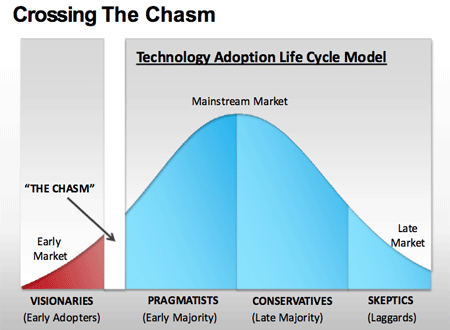I’ve been thinking a lot about investment theses and their development and use over these last few months. As I observe some of the theses that I’m investing against now, I find that investment theses move through a cycle similar to Geoffrey Moore’s Crossing the Chasm technology adoption life cycle model:

Source: Powerpoint-Templates on Slideshare
The earlier we develop a thesis, the further left on the graph we are. Thus, we truly are “Early Adopters” of this thesis because practically no one else has spotted yet, or very few. As we invest, we approach the chasm. This is where we find out if our thesis is right or not; if we are wrong, the thesis hits the chasm and falls to a brutal market death (taking our investment dollars along with it). Internet startups in this phase tackle the broad market since it is wide open with almost no competitors.
However if some of our investments start to do well, they gain market notice. Now other investors start jumping on the bandwagon. They too start to fund those startups which fit the thesis. Other (less imaginative) entrepreneurs start to see that startups got funded in a certain category before them, and they join in building startups too seeing that the investor community is beginning to favor these startups and raising money for them is easier. For internet startups, this begins the explosion of startups who start niche-ifying the early companies who tackled the broad market and try to do better by attacking a smaller segment more effectively than someone who is trying to satisfy the broad market. Series A investment rounds start populating the early startups who are still operating. This phase is the “Early Majority.”
Now the early startups have survived and gained a lot of traction and are making money and/or generating excitement by their growing size. Later stage VCs start funding series B and beyond, infusing large amounts of growth capital to companies whose traction has largely been proven. Still, entrepreneurs begin companies that tackle the space; for internet startups, this means not only further niche-ifying but also additional feature development for those things we wish the giants would do but do not have time to build.
At the end of the cycle come the laggards. This can mean simply that there are those who believe that they can still find some startup that can survive the existence of heavy competition that can grow to great heights. It can also mean that the next phase is IPO, as the largest of the companies drive towards the public markets and the stock market takes hold, which usually means there is significant traction and revenue generated. But paradoxically, once companies become big, history has shown that they stop innovating and then it can be a great opportunity for new investment theses to develop in areas where opportunity was disappearing not too long ago.
When I applied this to the theses I had been using up until now, I realized that two of my theses were racing along the graph now. And that was when I also realized that one of my theses was quickly moving beyond us.
What do I mean by that? As an early stage investor, we need certain parameters to fall into place for us to execute a meaningful strategy in selecting investments. One of these is the fact that startups we select must have market conditions maximized for their success. In the case of one of my theses, and when I applied this chasm graph to it, I realized that the market had definitely jumped the chasm a year or so ago and we were racing up through Early Majority and into Late Majority. When this happens, it means that there is still a market opportunity but just that this opportunity is not as viable for us at early stage as it was before. Mostly, this is because companies who emerge in this thesis category require a ton of capital to survive the market dynamics of fast, easy competition and a consumer attention problem of enormous proportions. You essentially need a lot of capital simply to go out and buy users to accelerate the customer acquisition process or else your chances of surviving by utilizing free methods of acquisition are too slow. At early stage, we simply cannot do things to move the odds in our favor any more; these investments become the province of those with a lot more capital than us.
Can you guess which of my theses I refer to?
Developing investment theses has been a fascinating exercise for me. However, now that I had developed some, it is even more fascinating to watch how I apply them to my investment strategy, see them evolve through years (sometimes months now), and then go through the mental and emotional exercise of dropping them when they are not valid for us any more.
When an Investment Thesis Moves Beyond You
Leave a reply